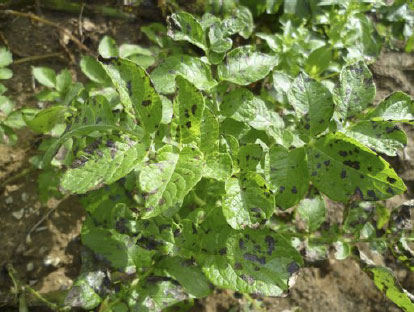|
Alternaria in potatoes – it’s all about timing
Cheadle, Cheshire, United Kingdom
June 28, 2013

Potato exhibiting typical signs of Alternaria
Alternaria is already a regular and significant disease in potatoes in mainland Europe and its incidence has recently shown a marked increase in the UK.
Caused by two species A. solani and the less pathogenic, but increasingly prevalent A.alternata, the disease is characterised by the appearance of distinct concentric ring lesions, often with a yellow margin. To the grower, the presence of Alternaria could mean significant yield losses of 20% to 30%.
Overwintering as mycelium, the spores are released in the spring and serve as the main inoculum source carried by wind and water. Consequently it is wet, mild, humid conditions that trigger high-risk conditions for crops at the right stage of development. “Once there is a high risk period of weather then the first signs of infection can be seen one to two weeks later,” advises independent potato specialist Howard Hinds, Root Crop Consultancy. “The showery weather we have just been experiencing is typically high risk so we would be expecting to see signs of disease developing in early July. As there is no curative treatment currently available for Alternaria it is vital that treatment occurs ahead of infection. Forecasting is therefore crucial to make a decision on the most appropriate treatment programme.”
“This year, because of the weather in the UK, the season is later than normal so as of mid-June there was no Alternaria in the crop. But now is the time to be vigilant and assess the risks especially if susceptible varieties such as Markies, Innovator and Vivaldi are being grown. Being complacent is not an option because when the symptoms are seen in the crop it is too late,” warns BASF’s agronomy manager, Phil Brown.
“We have been running trials over the past three years which use a Decision Support System (DSS) using a Dacom Alternaria model, currently based on A. solani although an A. alternata version is currently being developed. The model takes in local weather, as well as a five-day forecast and incorporates a crop stage element,” explains Phil. “The trials have shown that using the DSS and applying a fungicide early, and ahead of infection, gives the best activity. Where there is a combination of Alternaria and blight then Invader offers a great dual-purpose solution at the new 2.4kg/ha rate. The higher mancozeb dose (1,600g/ha) gives useful control of the Alternaria whilst the 18g/ha of dimethomorph offers local systemic activity of blight during rapid canopy development.”
“We are also finding that in high risk situations, Signum (Boscalid and pyraclostrobin), which has an EAMU for use on potatoes, can be an effective protectant treatment when applied at a rate of 0.25kg/ha with up to a maximum of four treatments. In trials, where this was used, in conjunction with the DSS, there was a lower % plant infection and disease severity. Providing an early warning system, and having the right products available, BASF hopes it can provide growers with the tools for a disease-free season,” advises Phil.
For details of BASF’s potato products go to: http://tinyurl.com/cjxj5tr
More solutions from:
. BASF SE
. BASF Agricultural Solutions
Website: http://www.basf.de Published: June 28, 2013 |